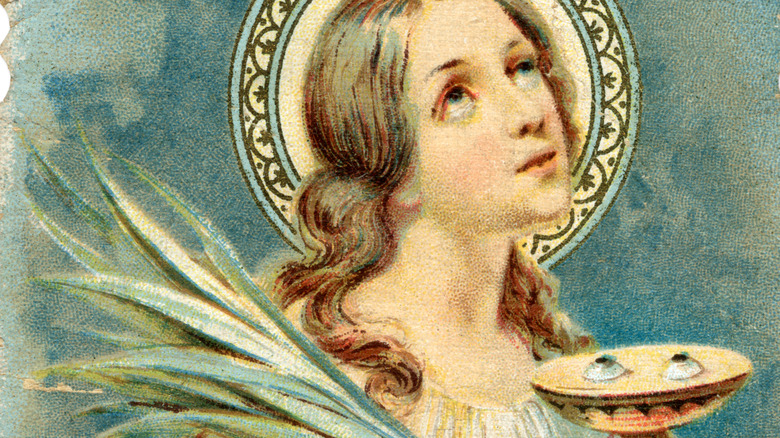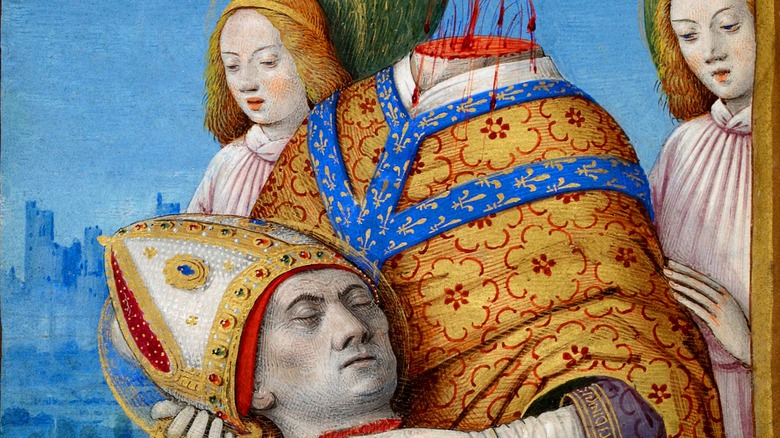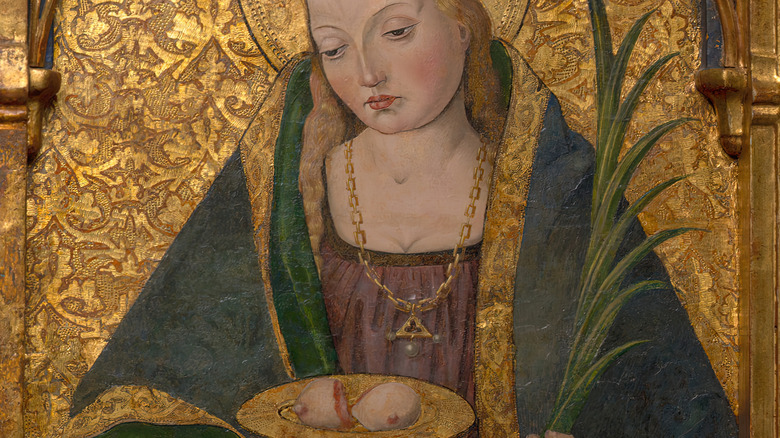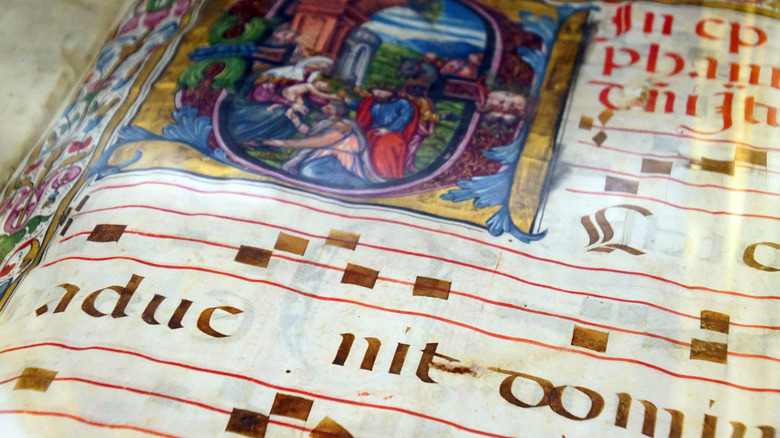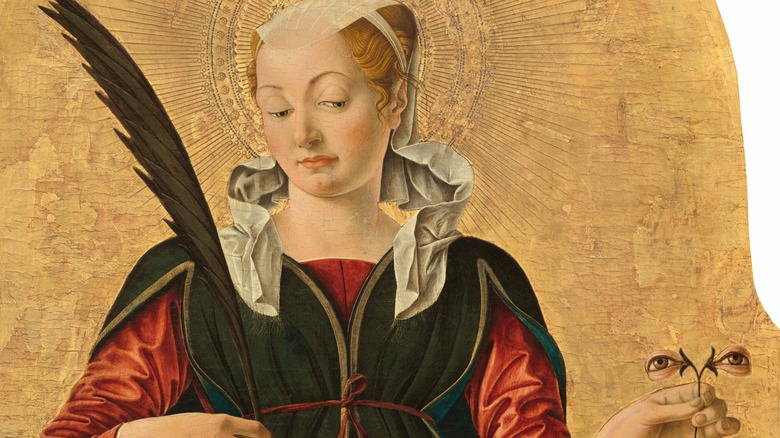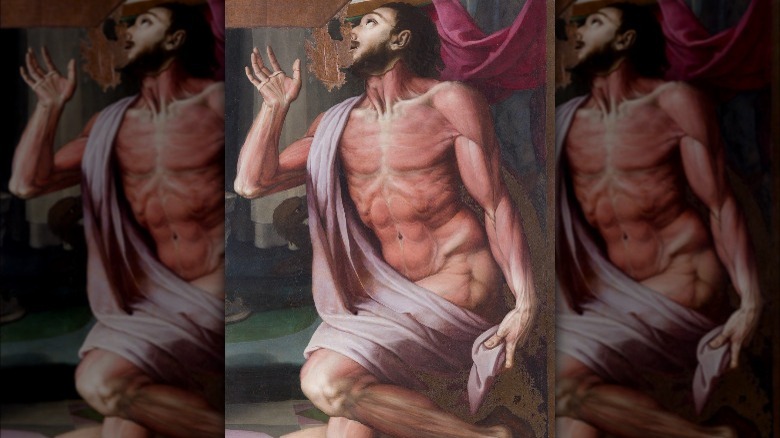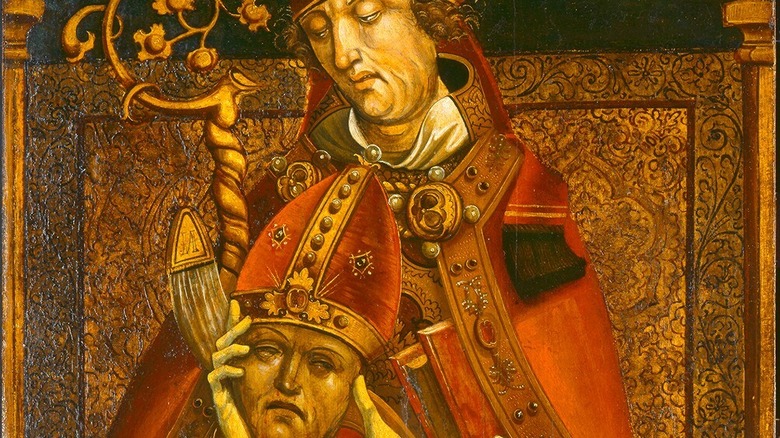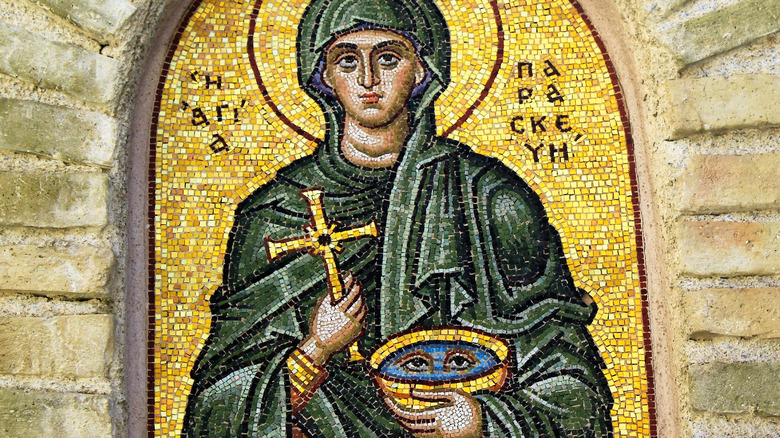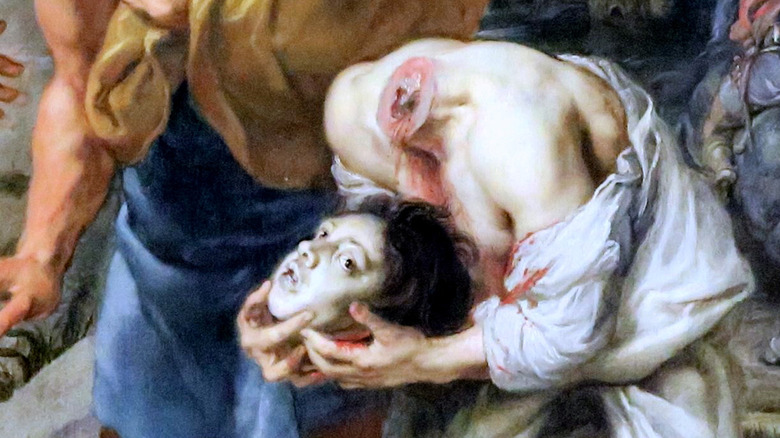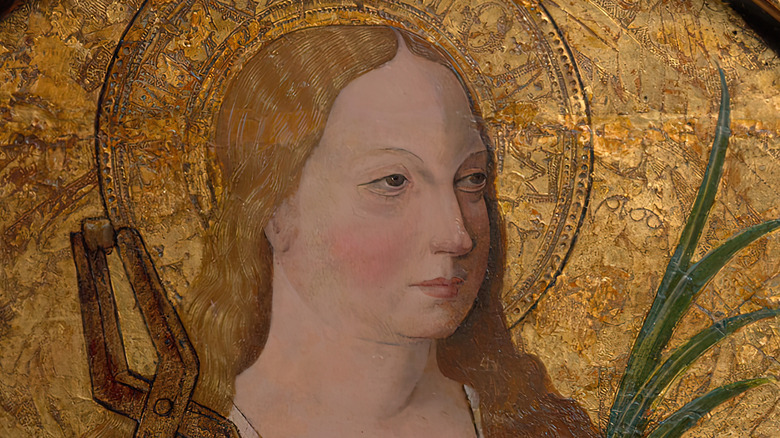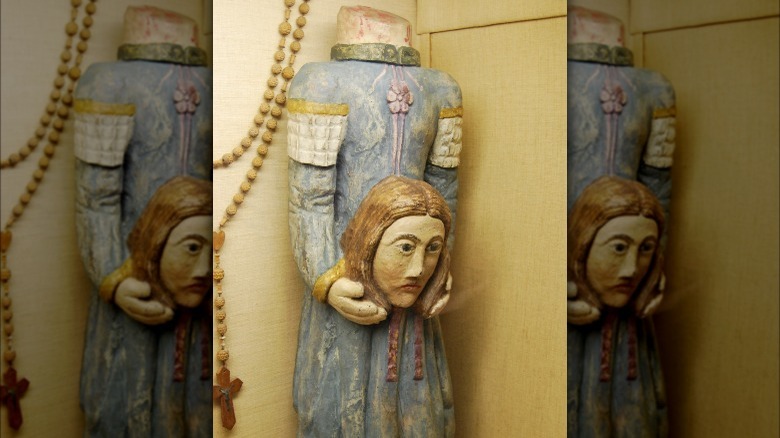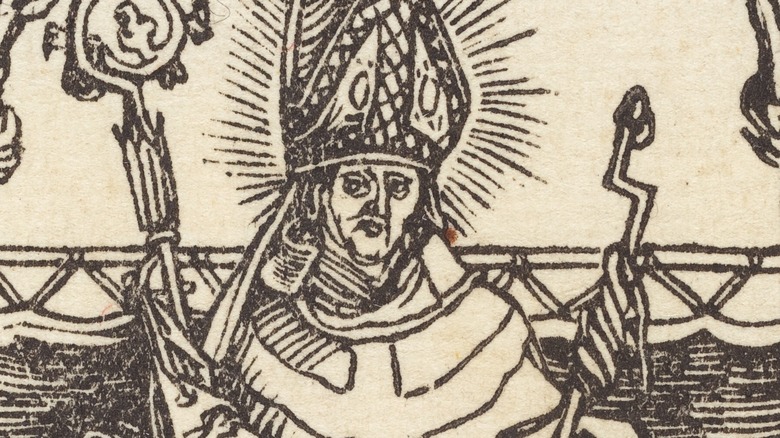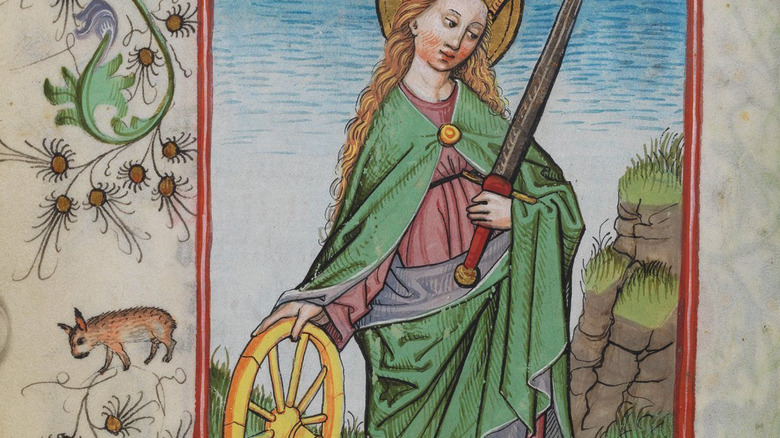Saints Depicted Carrying Dismembered Body Parts Explained
When looking at depictions of saints, it's not unusual to come across some perplexing images. Saint Peter is often shown with giant keys. Saint Thomas has an enormous T-Square, sometimes half his own size. Saint Pharaildis usually has a goose. Not all of them are so whimsical however. Many saints are depicted in gory scenes, holding their own heads or disemboweled entrails.
The reason for depicting them holding such unusual objects is often simply to make it easier to recognize individual saints. There are more than 10,000 saints currently recognized by the Roman Catholic Church. As described by the National Gallery, in order to tell saints apart, artists have given some saints specific symbols, so that viewers will know who they're looking at. It is much easier to know that the painting of a holy young woman is supposed to be Saint Gertrude of Nivelles if she is surrounded by cats or carrying her customary scepter covered in mice.
One of the most popular kinds of early saints were martyrs – people who chose to be killed rather than renounce their faith. As noted by Britannica, many of Christianity's most important saints were martyrs, including several apostles. Some of the stories of the brutal tortures and violent deaths they endured were based on fact, but many were legends designed to inspire Christians. Many martyrs were best known for their violent ends, so artists chose to depict them with things symbolic of their death – including their own body parts.
Denis of Paris
Saint Denis has become known as the patron saint of all of France. He is also the best known cephalophore, or saint who is depicted carrying his own head in his hands.
Saint Denis was the first bishop of Paris around the third century. As written in Historia Francorum (via Britannica), he was one of several bishops sent by the Roman Empire to Gaul in order to convert the local people to Christianity. Like many missionaries, he was not well-received, and went from missionary to martyr.
The historical details of what happened to Saint Denis are hazy, but the legend is famous. It is believed that the region's prefect had Denis killed. As written by Abbot Hilduin (quoted by Columbia University), Denis and the other evangelists were beaten and dragged through the streets. Finally, they were beheaded. According to legend, after his head was chopped off, Saint Denis' headless body stood up again. He picked his head up off the ground and "triumphantly" carried it for miles to the abbey, which is now The Basilica of Saint Denis.
Agatha of Sicily
Saint Agatha of Sicily is a famous saint, remembered for her martyrdom, alleged visions of the apostle Saint Peter, and a delicious pastry. She was one of the "virgin martyrs" who swore their virginity to God – but her portrayal is anything but common. Saint Agatha is typically depicted as holding a tray with a pair of breasts on a plate.
Little is known about Saint Agatha's early life, though as noted by Britannica, it is believed that she lived in the third century and was born into nobility. When she was a child, she swore to remain a virgin forever to honor the Lord. Her vow was tested when the Roman prefect of Sicily became obsessed with her. When Saint Agatha chose to keep her virginity rather than be with him, the prefect had her tortured and mutilated – including slicing off her breasts. Some sources state that she was killed by being burned at the stake. Legend states that when the pyre was lit, a massive earthquake rocked Sicily, and all the witnesses knew that her death would displease God. She was returned to prison, where she ultimately died.
As described in Italy Magazine, her hideous torture has inspired a popular pastry known as "Minne di Sant'Agata" or Saint Agatha's Breasts. They are a round, pink-icing-covered pastry with a candied cherry in the center. When paired on a plate, they resemble the plate of severed breasts that Saint Agatha is often shown holding.
Saint Osgyth
In the seventh century, another wealthy young woman would become a martyr – but this one was a princess. Unlike Saint Agatha, Saint Osgyth would survive her oath to stay a virgin, but she would die in a way that was just as bizarre.
Saint Osgyth's dream was always to become a nun, but as princess, it was expected that she would get married. As stated by "The Encyclopedia of Saints," she was married to the king of the East Saxons. Despite her marriage, Saint Osgyth was determined to keep her vow of virginity, and according to legend, there was a mysterious, magical entity on her side. Every time that the king attempted to get her alone to consummate the marriage a massive white deer appeared, and her husband would rush off on a stag hunt. While her husband was away, she persuaded powerful bishops to advise the king that Osgyth should be allowed to become a nun. Soon, she was the abbess of a new abbey in Essex.
According to the legend, when she was an abbess, she was set upon by rogue pirate raiders who were hoping to force her to make a sacrifice to their gods. She was decapitated in the struggle. Like Saint Denis, her headless body picked up her decapitated head and carried it to the church where she would be buried.
Saint Lucy
Saint Lucy, the patron saint of sight, was a martyr who was killed in the fourth century. As stated by Britannica, she was inspired by Saint Agatha. Like Saint Agatha, she is depicted presenting body parts on a plate – her own eyes. Unlike Saint Agatha, she removed them herself.
As described in "Saints Preserve Us!" Lucy's mother had a mysterious medical condition. The two went to Saint Agnes' shrine to pray. Lucy promised Saint Agatha that if her mother were healed, she would remain a virgin for the rest of her life and give away everything she owned to the poor. Her mother was saved, but Lucy's oath had terrible consequences. Lucy had a massive fortune, and it had attracted a fiance who was hoping to gain her vast wealth when they married. To punish her for her oath, he told the authorities that she was Christian (which was illegal).
Accroding to the legend, authorities first attempted to force her into prostitution, but she refused. She became immovable. Even when they summoned a team of oxen to drag her there, she couldn't be moved from the spot. The fiance who had betrayed her had often complimented her eyes, so when Lucy saw him, she tore out her own eyes and gave them to him. The authorities attempted to burn Saint Lucy at the stake, but she didn't burn. Finally, she was stabbed through the throat and died.
Saint Bartholomew
Before Saint Nathaniel Bartholomew was a saint, he was an apostle, missionary, and finally, martyr.
The site of his death is unknown, with some claiming he was killed in Phrygia, others stating it was India. As detailed in "The Encyclopedia of Saints," many believe that Bartholomew was martyred in Armenia. He is fabled to have brought an Armenian prince back from the dead, forced a devil out of him, and captured it. He is even considered the founder of the Armenian Church. Some, like Atlas Obscura, say that he converted the king to Christianity, and it was this that sealed his fate.
The method of his death is as controversial as where it took place. Some sources state that he was crucified upside down, but many believe that Bartholomew was first flayed, or skinned alive, and finally beheaded. He was occasionally depicted holding his own severed head like many other martyrs, but more often he is shown holding his flayed skin. Some are particularly gruesome, like Matteo di Giovanni's painting, which shows Saint Bartholomew as bright red and skinless, or Marco d'Agrate's sculpture which depicts him as skeletal with exposed muscles and tendons.
Saint Alban
Often considered the first martyr in Britain, Saint Alban was killed sometime between the third and fourth century, shortly after his conversion (via Britannica). Like many of the early martyrs, he was killed by the Romans – but the authorities thought that they were killing someone else.
As detailed in "Saints Preserve Us!" Alban was a Roman soldier. He encountered a priest who was on the run from the law and ended up being converted to Christianity. For a while, Alban sheltered the priest from the authorities, but he was ultimately discovered. He came up with another plan to save the priest: he would disguise himself and die in his place.
The priest and Alban switched clothes, and Alban was taken into custody instead. According to legend, Alban asked his captors for a drink of water, but they refused. Miraculously, a fountain burst into existence for him. They took him to be beheaded. The moment that the axe fell, the headsman's eyes suddenly fell out of his skull and rolled away. Alban's head fell into a holly bush, which is how he is usually depicted.
Paraskevi of Rome
In the second century, Saint Paraskevi was born to two devout Christians in the Roman empire. Like Saint Lucy, she was extremely charitable, and upon her parents' death, she gave away everything she owned. Also like Saint Lucy, she is often depicted holding a pair of eyes on a plate.
As described in "The Splendor of the Saints," Paraskevi became a nun and traveled around the world trying to convert people to Christianity. According to legend, Emperor Antoninus attempted to convert her instead. When she wouldn't renounce Christianity, he ordered her burned in hot oil. She was drenched in the boiling oil, but she would not burn. Confused, the emperor told Paraskevi to throw some of the oil at him. She flicked it into his face, and he was blinded. Taking pity on him, Paraskevi healed his wounds and restored his vision. Because of this, she is often depicted with a pair of eyes, and she's prayed to by Christians hoping for help with their eye conditions.
While the emperor freed Paraskevi for fixing his burns, that wasn't the last time she was sentenced to death for preaching her beliefs. According to the legend retold by Orthodox Church in America, the authorities attempted to feed Paraskevi to a giant snake, but she made the sign of the cross over it, and it died. The onlookers were so impressed, they all converted to Christianity, and she was again released. Finally, she was taken captive again, tortured, and beheaded.
Justus of Beauvais
Saint Justus is a third-century Gaulish cephalophore, often depicted with his own head in his hands. Like Saint Denis, this is not just a symbol of his martyrdom, but an event that is said to have occurred during the life of the "semi-legendary" saint (via Catholic Online). Unlike Saint Denis, Justus was a child.
As described in "Say What I Am Called: The Old English Riddles of the Exeter Book and the Ango-Latin Riddle Tradition," Saint Justus was only 9 years old. He and his father were visiting a city in hopes of ransoming a relative, but it was Justus who would soon be in custody. The authorities received reports that young Justus was a "Christian magician."
Justus was executed. After his decapitation, his body is said to have lifted his head in its hands. Then the head spoke directly to God, saying, "Lord of heaven and earth, receive my soul, for I did no harm and I was pure in heart."
Saint Apollonia
Saint Apollonia is a third-century martyr. Today, she is the patron saint of dentistry, but there is nothing medical about her story. Those suffering from toothaches were often encouraged to pray to Saint Apollonia (and as noted by the National Dental Association, if that didn't work, monasteries used to offer tooth-pulling services.)
It is believed that her father was a wealthy magistrate. He and his wife desperately wanted a child, so they prayed to all the gods they knew, but failed to get pregnant. When several pilgrims came to the city, the magistrate's wife excitedly asked them about their god. After hearing about the Virgin Mary, she tried praying to her for a child. Soon after, she became pregnant with a daughter – Apollonia.
Appolonia grew up to be a zealous preacher, frustrating the locals who had their own gods and customs. When Apollonia was elderly, legend states that she was attacked by a mob who broke her jaw and smashed her teeth out. They threatened to burn her alive unless she said something blasphemous, so she leapt into the fire herself. Some sources claim that her teeth were actually extracted, so she is often depicted holding dental forceps gripping a tooth – likely her own.
Saint Solange
Saint Solange (or Solangia) was a peasant girl in the ninth century. She was said to have lived in France, where she and her pious family raised sheep. As retold by The Congregation of the Sisters of the Divine Redeemer, Solange took a vow of chastity for the lord before she was 7 years old.
According to legend, one day, a count happened upon Solange while she was tending her flock. The Count propositioned her, but she rejected him. He tried to kidnap her, pulling him up onto his horse, but she escaped and jumped off the still-running horse. In some versions of the story, the villainous count stabbed her, but in others he decapitated her on the spot. Legend states that after she was slain, her body stood back up and carried her head to the local church.
As noted by "Saints Preserve Us!" the story of the holy shepherd girl killed by the dastardly Count became well known and made the populace more aware of class struggle.
Saint Erasmus
In the third century, Erasmus was in the mountains, hiding from the Roman authorities, being fed by a friendly raven. While in hiding he received a message from the Archangel Michael, telling him that he must go spread the gospel. He became one of the first bishops, but he was also brutally murdered.
As written in "The Encyclopedia of Saints," he was taken captive multiple times and freed by angels. He was attacked, covered in pitch, and set on fire, but he survived. At one point he preached in the midst of a thunderstorm, which may be why Erasmus, also known as Saint Elmo, lends his name to "Saint Elmo's fire," the glow from electricity in the atmosphere that sometimes appears with a crackling hiss around church towers and ship masts during storms. This connection to ships is why he is the patron saint of sailors, because he is said to be protecting them when the light appears. He is typically depicted holding a nautical device called a windlass – but it may not because he protects those at sea.
The windlass was a device turned on a crank to wind rope on a ship. According to legends about Saint Erasmus's martyrdom, a similar device was used to pull out his entrails. In some depictions, Saint Erasmus can be seen holding a windlass like a scepter, with his own guts still wrapped around it.
Other bizarre symbols of martyrdom
Not all martyrs were depicted carrying their own body parts. Throughout the years, artists came up with many ways to reference the ways that martyrs died.
Some martyred saints were shown with the injuries that they sustained during their torture or murder. As described in "Murder Most Horrid: The Grisliest Deaths of Roman Catholic Saints," (via Britannica) Saint Sebastian was ultimately beaten to death and his body thrown into a sewer, but he is most associated with a previous attempt to kill him. Generally, Saint Sebastian is depicted with multiple arrows shot into his chest and stomach.
Many martyrs were depicted holding the items that killed them. Catherine of Alexandria was a fourth-century saint, described as an Egyptian princess. As retold in "The Encyclopedia of Saints," when she converted to Christianity, she was condemned to be broken on what would come to be known as a "Catherine Wheel." She is frequently depicted with this implement of torture. Saint Stephen was a first century saint who was among the first to be killed by stoning. He is usually identified by the basket of rocks that he is holding. Saint Lawrence was likely beheaded in the third century, but according to legend he was grilled alive (during which he is supposed to have joked, "Turn me over, I'm cooked on that side.") Saint Lawrence can be identified because he often carries the grill with him.
